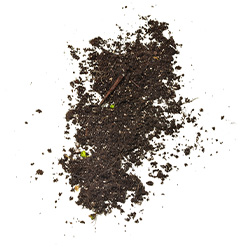Garden Soil: How to Improve Your Yard
A lush, happy lawn starts with balanced, well-tended soil. Here’s how to make the most of the ground you’ve got.
Everyone wants a vibrant, beautiful lawn, but not every lawn starts with the right foundation. If your lawn seems to struggle—in parts or as a whole—the problem may be deeper than the grass itself. The condition of your soil and the mix of nutrients feeding your lawn can determine whether your lawn thrives or dies. Fortunately, breaking down the science behind your soil and how to fertilize it is something you can master. Here’s how.
What is soil made of?
Soil, the layers of material over the ground’s surface, mainly consists of dead and living organisms, nutrients, particles (sand, silt, and clay), water, and air.
Shop This Story
What is soil, really?
You might refer to your lawn’s soil as “dirt,” but true soil is actually a mix of three ingredients: sand, silt, and clay, with an ideal combination of 40% sand, 40% silt, and 20% clay. This balance is called loam, and when you achieve it, your soil has what it needs to retain nutrients, drain excess moisture, and maximize air flow. It’s a boon to whatever you plant. You can find out the make-up of your soil using the simple mason jar test.
What happens if the soil ingredient ratio is off?
Several conditions can occur:
- Too much sand means your soil won’t retain nutrients or water and will dry out quickly.
- Too much silt means your soil is sticky and may have trouble getting rid of excess moisture.
- Too much clay makes drainage more difficult and requires more time to warm during the growing season.
How do you improve soil quality?
Luckily, it’s not difficult to bring your soil back to life.
- Use humus, peat moss, or nitrogen-enhanced sawdust to remedy sandy soil.
- Add sand or compost to improve silty soil.
- Work in compost, shredded leaves, or peat moss to loosen up clay soil.

What macronutrients do you need in soil?
If you’ve tested the pH balance of your soil and found it lacking, using macronutrients can both help improve your lawn’s health and boost your soil’s structure.
Having good loam can help your lawn thrive, but your soil also needs a balanced diet of macronutrients and the right pH so that it stays healthy and vigorous. Knowing what your current macronutrient mix and pH levels are can help you best judge how, when, and with what to fertilize or amend the soil.
Ideal pH for soils for lawns is between 6 and 7 (pH is simply a measurement of either acidity or alkalinity). If it’s below 6, your soil is acidic; lime can help raise that number. If it’s above 7, it’s alkaline and could benefit from sulfur.
In general, healthy lawns have adequate amounts of three macronutrients, each with a different function:
- Nitrogen (N) helps lawns grow tall, thick, and green, which in turn reduces the risk of disease.
- Phosphorus (P) generally helps lawns with vigorous growth.
- Potassium (K) helps lawns withstand temperature and moisture extremes.
How do you test soil pH and macronutrients?
A soil test is your best bet. You can choose the DIY route and use one from a home improvement store (brands such as Rapitest are widely available). Or you can request a soil test kit from your state, typically through a county extension office (results may include texture, nutrient and pH levels, and organic material).
In general, testing your soil once each year gives you a good idea how to adjust your fertilizing routine for optimum lawn growth. You should test before you apply any fertilizer, preferably in the spring.
“Sometimes you can visually see issues too,” says Eric Halfman, go-to-market manager for riding lawn equipment and utility vehicles at John Deere. “Dead grass, thinning areas, cracked soil, or soft roots are all signs your soil needs some attention.” Click here to read Halfman’s full interview on soil.
What do I do when I get the soil test results?
If you requested a soil test through your county or state, it usually comes with fertilizing suggestions. Use these to determine what you need to fertilize your lawn. Your soil test results may also tell you what type of fertilizer, such as organic or inorganic, to use.
Can’t I just buy a general purpose fertilizer?
You could, but you shouldn’t. Say your soil test suggests a 10/15/20 ratio of NPK, but you purchase fertilizer that has an 18/24/12 ratio. Not only are you not feeding your lawn what it needs, you’re wasting money and could contribute to fertilizer runoff, which can harm water supplies and wildlife. (FYI, the numbers represent a percent of the total weight of the fertilizer, not a percent that equals 100.) Instead, check the label on a product before purchasing it. You can get combo products or single-nutrient products. (Not sure how much to buy? Check out this fertilizer calculator to help determine per square foot needs.)
When do I fertilize my lawn?
Most recommendations are to avoid the hottest months of the year. If you live in the North, generally fertilize in the fall; residents of the South should mark late spring on their calendars. Check out our month-by-month lawn care guide for more.
Shop This Story
Organic fertilizer vs. inorganic fertilizer: What’s the difference?
Organic and inorganic fertilizers differ in a couple of key ways.
- Organic fertilizers, made from plant or animal materials, take more time to break down and promote beneficial bacterial and fungal activity. But organic fertilizers are less suited for fall application, as lawns can’t really break them down before colder temperatures set in.
- Inorganic fertilizers are synthetic but are immediately available for your lawn to break down. If you need help fast, inorganic fertilizers may come to the rescue more quickly. Whichever you choose, make sure the mix of nutrients matches the recommendations of your soil test.
Which tools can help you fertilize?
Fertilizer typically comes in large bags, but spreading it by hand can be cumbersome and inconsistent. A better bet is to invest in a spreader. Spreaders are generally sold by area of coverage.
For very small lawns or small patches of lawn you’re repairing, a hand-held spreader may do the trick. These are operated by turning a crank by hand while you stand over or walk around the area being fertilized. Larger lawns can be covered with either push spreaders or tow-behind models that can hold up to several hundred pounds of fertilizer at once.
Push-behind broadcast spreaders drop fertilizer in a predetermined radius, so consider one that has the ability to block fertilizer spread, which is helpful in preventing you from inadvertently fertilizing a flower bed with lawn fertilizer. Push-behind drop spreaders, on the other hand, have a specified width but smaller coverage area with each pass, so you’ll sacrifice speed for accuracy of coverage. Tow-behind models hook up to a lawn tractor to spread fertilizing products. With any spreader, you’ll need to make careful work of the area you’re fertilizing so you don’t miss spots.
In general, the smaller the spreader, the more passes you’ll have to make for total fertilizer coverage. In addition, lighter weight fertilizers have a tendency to drift when applied, so consider your fertilizer choice and your spreader options before making a purchase.


